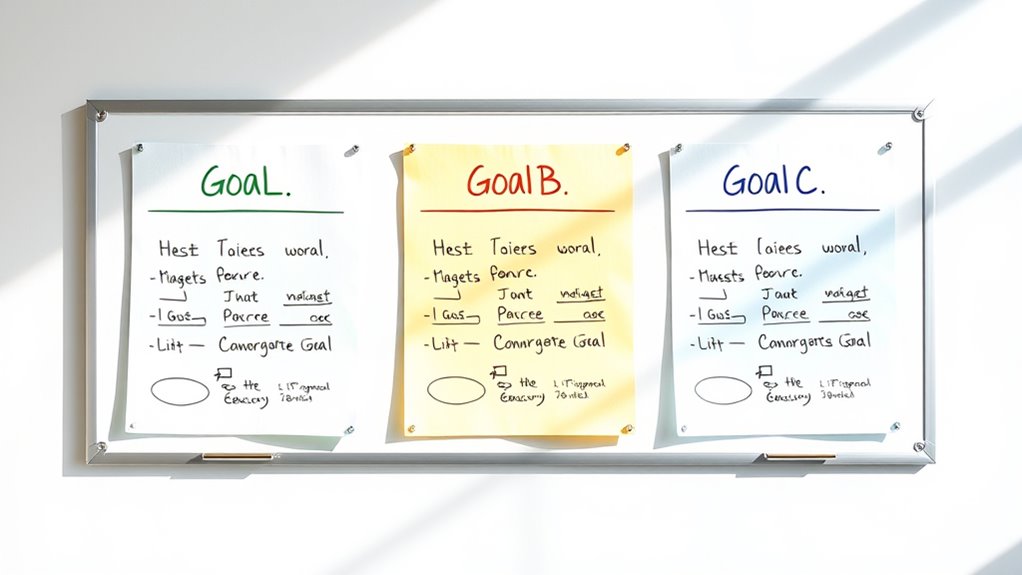To set A, B, and C targets like a pro, start by clarifying your primary objectives (A goals) that align with your big-picture vision. Break those down into specific milestones (B goals) and smaller tasks (C goals) that support each milestone. Focus on priority, ensuring each level flows logically to the next. Regularly review and adjust your goals to stay aligned and motivated—continue exploring to master effective goal layering.
Key Takeaways
- Prioritize goals by categorizing them into A (top), B (supporting), and C (nice-to-have) levels for clarity.
- Start with high-priority A goals, then break them into measurable B milestones and specific C tasks.
- Ensure each goal level directly supports the next to maintain strategic alignment and focus.
- Regularly review and adjust goals to stay aligned with changing priorities and resource availability.
- Use structured goal hierarchy to prevent overwhelm and streamline resource allocation effectively.
Understanding the Concept of Goal Layering

Understanding the concept of goal layering is essential because it helps you organize your objectives into manageable levels. When you align your goals through priority alignment, you create a clear framework that supports strategic planning. This process involves breaking down broad, long-term ambitions into smaller, actionable targets, making progress easier to track and adjust. By layering your goals, you ensure that each level supports the next, maintaining consistency and focus. It prevents you from feeling overwhelmed by trying to tackle everything at once. Instead, you concentrate on the most important tasks first, then build upon those achievements. Effective goal layering keeps your strategic planning organized, ensuring your efforts are directed toward the right priorities at each stage. Additionally, understanding risk assessment helps in setting realistic performance benchmarks for your objectives, much like choosing the right safety features in equipment to ensure smooth progress. Incorporating knowledge about market volatility can further refine your goal setting by preparing you for possible fluctuations, much like diversifying your assets in a Gold IRA to mitigate risks.
Differentiating A, B, and C Goals

How can you effectively prioritize your goals? The key is understanding the differences between A, B, and C goals. A goals are your top priorities, directly aligned with your strategic focus, and drive your overall success. B goals support A goals and help you stay on track, but they’re less urgent. C goals are tasks or ambitions that are nice to achieve but don’t impact your main objectives. Differentiating these categories sharpens your priority alignment, ensuring you allocate resources and time wisely. By clearly defining each goal type, you prevent distraction and maintain focus on what truly matters. This structured approach enables you to remain strategic in your efforts, making it easier to achieve meaningful progress without getting overwhelmed by less critical tasks.
Applying Goal Layering to Achieve Success

Applying goal layering involves organizing your goals into a structured hierarchy, guaranteeing that each level supports the next. Start with your A goals, which are your primary objectives, then break them down into B goals that serve as milestones, and finally identify C goals that act as specific tasks. Use priority planning to identify which goals need immediate focus and which can wait, helping you allocate resources effectively. Motivation strategies come into play by aligning each level with your core purpose, keeping you engaged. Regularly review and adjust your goal hierarchy to maintain clarity and momentum. Incorporating strategic goal setting can further enhance your planning process by ensuring your objectives are aligned with your overall vision. Additionally, understanding the importance of clear goal definition helps prevent ambiguity and guides focused efforts. This structured approach keeps you focused, prevents overwhelm, and ensures that every action contributes to your bigger picture success.
Frequently Asked Questions
How Do I Prioritize My Goals Effectively?
When figuring out how to prioritize your goals, focus on priority alignment and goal hierarchy. Start by identifying which goals have the greatest impact and align with your long-term vision. Break down larger goals into smaller, manageable tasks, then rank them based on urgency and importance. This approach helps you stay focused, guarantees your efforts support your overall objectives, and makes it easier to tackle goals systematically and effectively.
Can Goal Layering Be Used for Personal Development?
Did you know that 92% of successful people focus on mindset shifts and habit formation? Yes, goal layering works for personal development too. By setting layered targets, you create clear steps that build momentum. It helps you stay motivated, prioritize effectively, and develop consistent habits. This approach encourages continuous growth, making your personal goals more manageable and achievable over time. So, give goal layering a try for lasting self-improvement.
What Tools Assist With Tracking Layered Goals?
To track layered goals effectively, you can use tools that incorporate SMART criteria, ensuring your goals are Specific, Measurable, Achievable, Relevant, and Time-bound. Visualization techniques, like digital boards or apps, help you see progress across different layers. Apps like Trello, Asana, or Notion let you organize and visualize your goals, keeping you focused and motivated as you move toward your A, B, and C targets.
How Often Should I Review My Goal Layers?
Coincidentally, reviewing your goal layers regularly keeps you aligned and motivated. You should ideally check them weekly or bi-weekly, depending on your project scope. This way, you can adjust your goal visualization and motivation strategies, ensuring you stay on track. Consistent reviews help you spot obstacles early and celebrate progress, keeping your momentum high. Regular check-ins make your layered goals more manageable and keep your focus sharp.
Is Goal Layering Suitable for Team or Organizational Goals?
Goal layering is highly suitable for team alignment and organizational strategy because it helps clarify priorities across levels. By breaking down overarching goals into actionable targets, you guarantee everyone understands their role in achieving the bigger picture. This approach fosters collaboration, improves focus, and keeps your team aligned with strategic objectives. Regular reviews reinforce progress, so you can adapt plans as needed, maintaining momentum toward organizational success.
Conclusion
By mastering the art of goal layering, you propel yourself toward progress with purpose. Set clear, strategic steps—A, B, and C goals—that create a compelling chain of change. Remember, deliberate decisions drive dynamic development, turning dreams into doable deeds. Stay sharp, stay strategic, and let your layered goals lead you to lasting success. With focus and finesse, you’ll forge a future filled with fulfillment and freedom.









